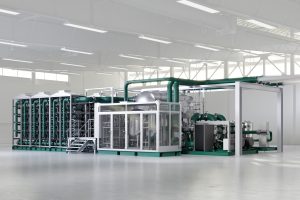networks, regulating stations, and end use infrastructure. For example, natural gas transmission and distribution companies can blend hydrogen into their distribution systems, reducing emissions when the blended mixture of hydrogen and natural gas is burned in homes for cooking, heating and other uses. Industrial end users can reduce emissions by using a mix of hydrogen and natural gas as fuel for turbines used for power generation.
“To ensure product quality, safety and conformity, Emerson is collaborating with the testing and certification agency Bureau Veritas Italia, and it has developed internal procedures to assess the suitability of products to be used in gas infrastructure applications,” said Oscar Bressan, standardization and product engineer with Emerson’s pressure management research and development team.
“The Emerson procedures describe the requirements, tests, and inspection methods for metallic and non-metallic materials, as well as internal and external sealing necessary to use pressure control products in contact with natural gas and blended hydrogen, or pure hydrogen. After the first certification obtained for the Emerson BM6X Series Slam-Shut valve, Emerson will continue to certify other equipment used in hydrogen infrastructure to ensure sustainability and reliability for this rapidly developing market.”






